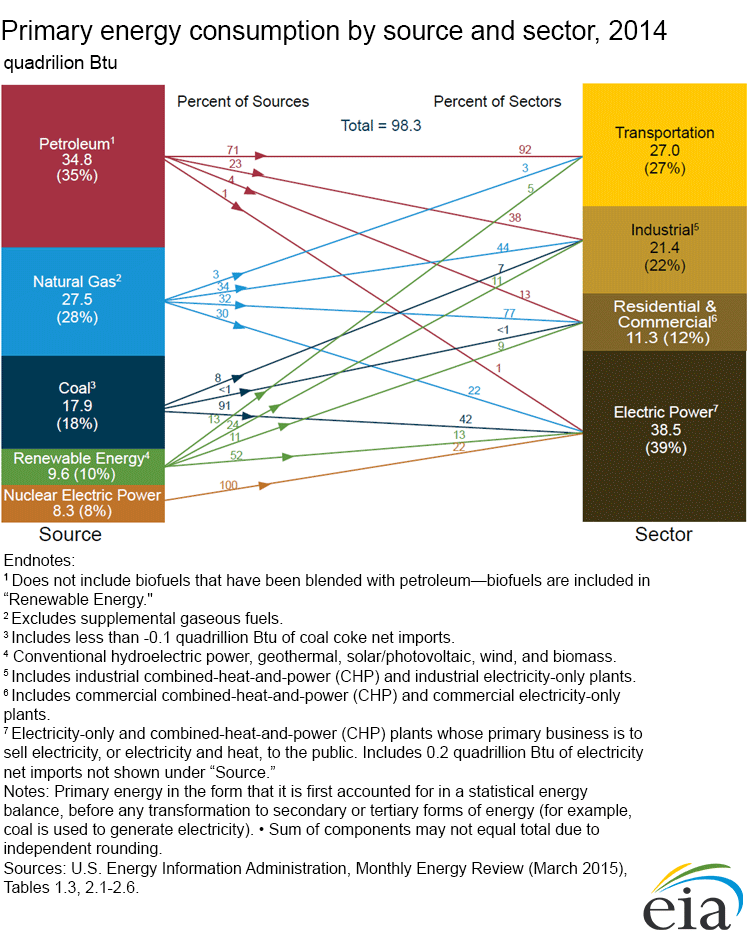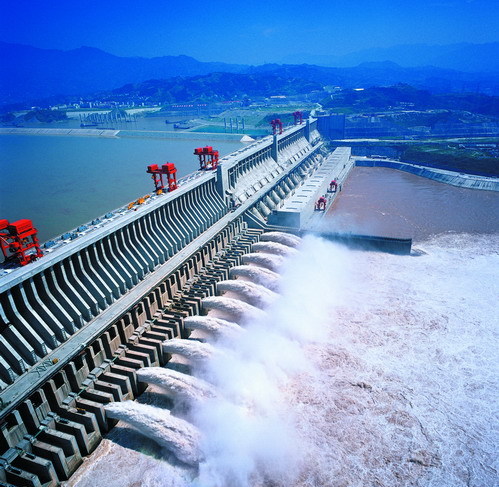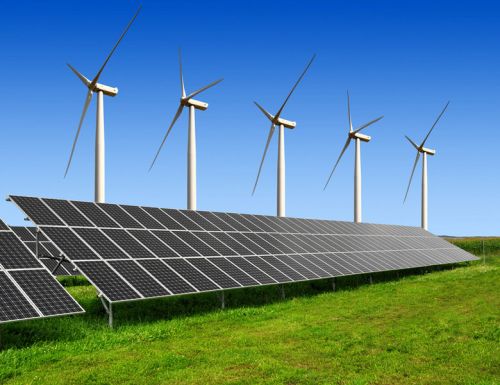There's no denying that the climate is changing due to all the fossil fuels that we're burning. It would be great if we could just replace all of that, but it's going to take gradual changes. What solutions are actually out there to replace all of the stuff we've been burning for the last 150 years?
Listen to the Retrospectical Podcast Episode 18 - Clean Alternative Energy Today & Tomorrow
We currently still burn coal and natural gas for the majority of the electricity in the United States. Natural gas is only about half as bad as coal, and has been taking over some of the share that coal once had. These are still both ultimately a limited resource, natural gas reserves in the United States are projected to last just over 80 years. Coal reserves are larger, projected to last 260 years at current rates, but that's an awful lot of carbon to be released into the atmosphere.
It's simply unreasonable to think that society could continue long-term and continue to rely on fossil fuels.

Wind – Wind energy is consistent on a year-to-year basis in terms of total power generated, however it does fluctuate a lot over the short term. Sometimes, the wind just isn’t blowing. It’s a very cheap alternative to coal and gas, after all, the wind is free. Wind farms can be found all over the country now with 5% of the US's energy is now wind generated.

Denmark has 14 offshore wind farms which powers about 40% of their homes. On some windy days, the entire power consumption of the country can be covered by wind power alone. Offshore wind is more consistent and has less of a visual impact (a pet peeve of mine – who really has a problem with the look of a new wind turbine anyways?). The downside is that construction and maintenance of offshore wind farms is much more expensive, for obvious reasons. 11.4% of the electricity in the EU is now generated by wind power, with the entire world at 4%.
How does it work? – Like most ways of generating electricity, all it takes is the rotation of some magnets, and viola, you’ve got power. Wind turbines are some of the most basic, borrowing a few tricks from the airplane industry to make the fins more efficient in the wind, they just rotate a central shaft and electricity is made.
What are the benefits? – Well, aside from the initial capital costs, the cost to operate a wind turbine is very low, with maintenance being the only real expense. There is no fuel for the turbines to run on, and the impact to the environment is minimal. Wind farms do need to be spread out over a large area (typically, they are separated by a distance of at least 7x the diameter of the fins), but those areas can still be used for farming and other land-intensive uses. Putting a wind farm out at sea further reduces its impact on regular life and increases its efficiency, at a higher initial and maintenance cost, of course.
What are the downsides? – Well, to put it simply, they don’t work if the wind isn’t blowing! Wind power is efficient and reliable over the long haul, but it must be supplemented with other forms of electricity to be a part of the power grid.
One of the interesting things you can do with wind is compliment it with hydroelectric power. When the wind is working well or there is little demand, you can shut off the hydroelectric dam, or even pump water back into the reservoir (the greater the pressure behind a hydroelectric dam, the more power it generates).

Solar - Solar prices continue to fall, with prices continuing to approach the cost of fossil fuels, making solar power a very attractive clean energy option. Solar power has experienced incremental improvements over the last couple of decades that have made it more and more competitive in the modern markets.
Like wind energy, solar is intermittent, meaning that it must either be used immediately, stored immediately, or sent into the power grid along transmission lines to be used immediately. Solar is still emerging when it comes to widespread use, accounting for only 0.6% of all energy sources in the US.
How does it work? – Electricity can be generated with the sun in two different ways. First, there are traditional solar panels using photovoltaic cells, commonly known as solar cells. This technology is what has seen gradual improvements over the last couple of decades and now these panels can be seen in giant arrays that are essentially power plants – the largest of which can generate 579 MW (about the capacity of the US’s second largest wind farm). Unlike more traditional ways of generating electricity, there is no heating of water involved here. The sunlight shining on the PV cells knocks electrons loose and creates a potential difference – thus creating a voltage and usable electricity. This process is more efficient as the sun gets brighter (sunny days) or more intense (more direct rays, nearer to the equator).
The second way to create energy with solar power is using a system to concentrate the solar power, also known as solar thermal energy. There are several implementations of this technology currently in use, including the parabolic trough. In this method, a tube of some kind of fluid is placed at the focal point of a reflective parabola and the entire unit is rotated throughout the day for maximum effect. This is currently the most efficient use of land in a solar power setup. You can also make a solar power tower, which is just kind of badass. In Spain, the PS10 and PS20 solar plants have been built and they are pretty impressive looking. A field of mirrors are all set just right and rotate throughout the day so they all concentrate the sunlight into a very small area on the tower, which superheats water to 275 degrees Celsius.
 A solar thermal energy plant in Spain.
A solar thermal energy plant in Spain.
What are the benefits? – Generally considered much more aesthetically pleasing than wind turbines, solar panels and solar farms do not suffer from the same NIMBY issues that have kept wind from spreading more. Solar also lends itself to a more “off the grid” approach. In areas with high amounts of sunlight, a battery storage system like Tesla’s Powerwall is all you need to make sure you have electricity 24/7. Solar is more consistent than
In some areas of the country, you can have your house totally done up with solar panels and the cost is basically free. A company called Sunpower will install all the panels and hook them up to the system for zero money up front. You wind up making monthly payments that are roughly equivalent to your old utility bill to pay down the system. You can also, like wind power, sell your excess energy back to the power grid. Imagine a nice hot day where you’re running your AC, watching TV, eating ice cream and still sending spare power back to the grid for a profit.
What are the downsides? - Well, there’s still a long way to go in terms of efficiency in solar power. The best solar cells are still only about 40% efficient, so there’s still a lot of room for improvement. The initial cost is also very high, and could easily take 10-15 years to pay off the investment (the Sunpower option looks like it could be 20 years). The availability of sunlight is also an issue – people living in more northern latitudes are not going to get as much out of solar energy and thus it is more expensive. PV cells are also made up of some elements that can be toxic to the environment and these items must be disposed of properly. You also need a lot of land if you want to build a solar plant, and unlike wind, this land can’t really be used for farming. Finally, as we know here in Chicago, the sun is just not going to shine all the time.
Hydroelectric – Hydroelectric power is probably the oldest and most well established clean energy source, with it being produced in 150 countries. Hydroelectric plants account for 9 of the 10 largest power plants in the world. China alone generates 17% of its entire domestic energy with hydroelectric plants, aided by the new Three Gorges dam, the largest power plant of any kind in the world. The Three Gorges Power plant generates a whopping 22,500MW, compared to the US’s largest plant, Grand Coulee, producing 6800MW. (Hoover dam has a capacity of 2000 MW).
 The Three Gorges Dam in China.
The Three Gorges Dam in China.
Some countries are already very big into hydroelectric power. Norway gets 98-99% of its electricity exclusively from hydroelectric sources. Paraguay gets 100% of its electricity from hydroelectric dams, thanks to the giant Itaipu dam on the Paraguay-Brazil border. Paraguay actually exports about 90% of the energy it creates to Brazil, thanks to this and several other dams throughout the country.
How does it work? – In most cases, certainly in all of the largest cases, a large dam is built in order to build up a reservoir so there is a constant supply of water with a very high pressure behind it. A larger height behind the dam results in an increase flow rate of the water and thus more power is generated. Then it’s very simple, just like most power plants, water (this time it’s not heated to steam, but used as its falling) turns a turbine which generates the electricity needed.
What are the benefits? – Hydro power is very flexible, needing only a couple of minutes to go from a cold start to a full load. This allows power production from the hydro plant to be increased or decreased based on demand. These plants are relatively cheap to run and build (the three gorges dam will cover their costs in just 5-8 years after full output), and provide very low cost electricity, from only 3 to 5 cents per KWh. It’s also very clean, generating only a bit of Co2 during construction.
What are the downsides? – The large reservoirs that are built to power a hydroelectric dam destroy the environment that once existed there. Large amounts of silt can accumulate upstream, filling up the reservoir in extreme cases. This decreases the nutrients in the water downstream. Dams are also a huge impediment for migrating fish. Water levels can also vary in some areas based on seasonal rain/snow fall and a reduced level in a reservoir will lead to a lower power production. Dam failures can be catastrophic and have killed more people than nuclear accidents.
Nuclear - 20% of our power comes from Nuclear. It's considered a carbon-free energy, but does generate nuclear waste. All of our power plants were built no later than the 1970's, so one of the big problems we have now is that we're working with old technology.
How does it work? - A Nuclear plant works just like any other power plant we have (coal, natural gas, etc). Heat from burning fuel (uranium in this case) is used to heat up water, turn it to steam and use the steam to turn turbines. It's all pretty simple and has lots of benefits, as well as some pretty big downsides.
What are the benefits? - Nuclear power does not produce any carbon emissions - in that sense it's a clean energy and does not in any way contribute to global warming. So this is definitely, when done right, helping our situation right now. Of course, nuclear power does generate some awfully nasty waste, but we'll get to that in a moment.
Traditional ore deposits account for about a 200 year supply at current consumption rates, with about another 280 years undiscovered in the ground. The big hope for the future is that re-use of current waste stockpiles and new technologies can extend the life into the tens of thousands of years.
What are the downsides? - Well, the nuclear waste that is leftover once the life of the fuel rods is over is a big problem. The current storage options are inefficient and could take tens of thousands of years to be safe. The actual power plants are also potentially very dangerous, as has been seen in Chernobyl, Three Mile Island, and most recently in Fukushima.
Clearly, there are some very serious issues when it comes to nuclear power, but it is getting better. For example, a young Nuclear Physicist named Taylor Wilson presented a TED talk in 2013 about his idea for a sealed molten salt reactor that would supply 50 MW on average and only need to be refueled every 30 years. It would even run on decommissioned nuclear weapons. And if you're unsure if Wilson knows what he's talking about - he's the kid who was just 14 years old in 2008 and became the youngest person in history to achieve nuclear fusion.
Other Alternatives - Biomass - This is considered renewable because instead of burning something we dug out of the ground, we burn trash, wood, crops, sewage and animal waste. This is common in some areas where landfills are not practical. In fact, Hawaii uses a significant amount of biomass energy to help supplant wind and solar.
Geothermal energy can also be used to generate electricity. Geothermal is the most efficient renewable source, with plants operating at 92% of its capacity, compared to 34% for wind and 25% for solar. There are also biofuels like ethanol and biodiesel, generally used for vehicles now.
Hydrogen power can provide some remarkable steps forward for transportation fuels, but there are a few hurdles to cross. It is definitely dangerous, but then again, so is gasoline. It also takes a lot of electricity to generate the hydrogen. Once you've got it, however, it burns really clean, the only exhaust is pure water. Currently, hydrogen gas is mainly used for rocket fuel, but there's actually 12 hydrogen gas stations in California, but vehicles are not that widespread since that's the only place you can fill up.
Fusion - Fusion is the holy grail of energy. In theory, a sustained fusion reaction will be clean and actually output more energy than it takes to start the reaction. Currently, however, we're not there yet. It still takes more energy to start the reaction than we get out of it, and we haven't found a way to sustain the reaction yet. There's a huge lab in California, the National Ignition Facility that is working on Fusion. In France, they are building ITER, a gigantic combined effort research megaproject. The goal of this reactor is to actually prove that you can get more energy out than you put into the system. It's designed to output 500MW, while only needing 50MW to operate. It's not happening any time soon though, as this project isn't expected to start running experiments until at least 2027.


